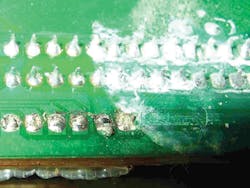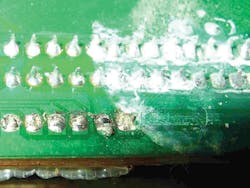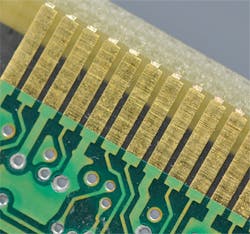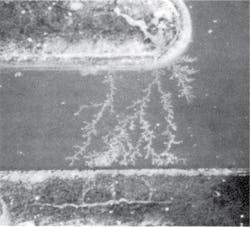Managing Corrosion, Maintaining Electronic Connections
Water treatment facilities, be it drinking water, wastewater reclamation or desalination plants, experience problems with electronics unique to the industry. Meters, sensors, data connections, and communication lines utilize low-voltage signals that are highly susceptible to corrosion.
Corrosion exists when three things are present: metal; an oxidizer (oxygen in the air); and moisture. Dissimilar metals in connections create a current that actually helps to grow the corrosion. Treatment facilities have more contributing factors than most environments — water vapor, salts or other chemicals such as sulfur or methane, deteriorate metals through corrosion.
At the microscopic level, metal contact surfaces are not smooth with full area contact. Signals or current flow between the peaks and valleys on the surface. Excess corrosion can prevent the needed contact between the metals, distorting or eliminating connectivity. Likewise, excess corrosion can push connector pins apart, causing signal intermittencies.
Printed circuit board, non-functioning due to corrosion/moisture infiltration.
The key to maintaining and maximizing electronic connectivity is to ensure connectors are clean and free from corrosion down to the microscopic level. Even if metals look clean, corrosion may still be present. In a low-voltage application, microscopic corrosion can cause failures, including micro-signal rate fluctuations that lead to excess heat, false data, cascade failures and more.
Most contact cleaners contain a volatile chemical designed to evaporate quickly such as methanol, or ethyl or isopropyl alcohol. Such cleaners simply evaporate too quickly to eliminate the corrosion at the microscopic roots where it is adhered to the metals.
The ideal solution uses a hydrocarbon-based contact cleaner that will remain on the surface to eliminate every bit of corrosion. Be sure it is not an alcohol-based cleaner with a lubricant added, as the cleaning properties will vanish quickly leaving only the lubricant. The DeoxIT® D-Series from CAIG Laboratories is an oil-based cleaner that is safe on most materials and will eliminate oxidation down to the microscopic level. DeoxIT will also lubricate and protect the metals, ensuring the highest possible conductivity and signal rates.
Connections appear clean (even after using generic contact cleaners or alcohol) but corrosion you can’t see remains at the microscopic level.
DeoxIT can be applied wherever you are experiencing signal degradation. This includes edge connectors, DIMM sockets, A/V and RF connections, transducers, flow meters, or door switches. Taking this simple step will eliminate oxidation/corrosion, increase/restore connectivity, and extend equipment life.
Several treatment facilities are already using DeoxIT with excellent results. One municipal treatment facility engineer noted that, after using the cleaner, it was the first time in his many years that all green lights appeared on his SCADA board. WW
CAIG Laboratories offers an extensive array of cleaners, lubricants, enhancers, preservatives and accessories for electronic, electrical and mechanical applications. CAIG’s DeoxIT® Products are environmentally safe and CAIG is constantly developing new products and applicators. Learn more at caig.com.
Circle No. 309 on Reader Service Card



